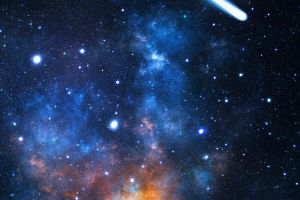In the vast expanse of the universe, the distances separating celestial objects are so immense that traditional units such as kilometers or miles become unwieldy and impractical.
To navigate this cosmic scale, astronomers employ units like the light year to express how far light travels through space in a set time.
What is a Light Year?
A light year represents the distance light travels through a vacuum in one Earth year. Given that light moves at a staggering speed of approximately 300,000 kilometers per second (roughly 186,000 miles per second), the distance covered in a single year is immense—about 9.46 trillion kilometers. This unit allows astronomers to express the separation between stars, galaxies, and other celestial bodies with practical brevity. Important to note is that a light year is a measure of distance, not time, despite containing the word "year".
The use of light years is essential because light itself is the carrier of information in the universe; the farther away an object is, the longer its light takes to reach observers. Consequently, looking at distant cosmic phenomena is equivalent to looking back in time, illuminating the universe’s history and evolution.
Alternative Cosmic Distance Measurements
While light years are common in popular science, professional astronomers also employ other units tailored to specific distance ranges:
Astronomical Unit (AU): Defined as the average distance from Earth to the Sun, approximately 150 million kilometers. This unit is ideal for measuring distances within the Solar System, such as between planets.
Parsec: Derived from "parallax arcsecond," a parsec is approximately 3.26 light years. It originates from measuring stellar parallax—the apparent shift in position of nearby stars due to Earth’s orbit.
Megaparsec (Mpc): Equal to one million parsecs, this scale is used for vast intergalactic distances, reaching into the fabric of the observable universe.
Techniques for Measuring Cosmic Distances
Measuring cosmic distances is a complex endeavor necessitating a "cosmic distance ladder," employing several interdependent methods that work together to calibrate vast ranges:
Parallax: The foundational method employed for nearby stars, parallax involves observing a star from different positions in Earth’s orbit around the Sun and measuring its apparent shift against distant background stars. Accuracy diminishes with distance due to the tiny angular shifts involved.
Standard Candles: For more remote stars and galaxies, astronomers utilize objects with known intrinsic brightness, such as Cepheid variable stars or Type Ia supernovae. By comparing the known absolute brightness to observed brightness, distances can be inferred through the inverse-square law of light intensity.
Redshift and Hubble’s Law: On extra-galactic scales, the universe's expansion causes light from distant galaxies to stretch toward longer, redder wavelengths. Measuring this redshift quantifies recessional velocity, which can be translated into distance using Hubble’s constant, connecting cosmic expansion rate with distance.
The Significance of Cosmic Distances in Astronomy
Understanding cosmic distances is not merely academic, it is pivotal in unraveling the universe’s origin, composition, and fate. For example, determining accurate distances to galaxies helps map the large-scale structure of the cosmos, revealing galaxy clusters, voids, and filaments features integral to cosmology theories.
Knowledge of distances also facilitates determining intrinsic luminosities, masses, and sizes of celestial objects, parameters essential for developing models of stellar evolution and galaxies formation. Furthermore, light travel time enables the study of cosmic history, providing a look at how celestial objects and structures appeared at different epochs.
Astrophysicist Dr. Edwin Hubble, whose work laid the foundation for modern cosmology, once stated: “Equipped with his five senses, man explores the universe around him and calls the adventure Science". Contemporary cosmologist Dr. Neil deGrasse Tyson emphasizes the role of cosmic distance understanding: “To know the universe, one must measure it. Distances are more than numbers — they’re time machines that propel humanity forward in comprehending our place among the stars".
Challenges and Future Prospects
Despite advancements, measuring cosmic distances remains fraught with challenges—instrumental limitations, cosmic dust obscuring observations, and uncertainties in calibration methods persist. Ongoing and future missions, such as the Gaia observatory, aim to refine parallax measurements with unprecedented precision, expanding the radius over which distances can be reliably measured.
Light years provide a fundamental scale for grasping the mind-boggling distances separating cosmic entities. Through layered techniques—the cosmic distance ladder—astronomers can chart the universe from nearby stars to remote galaxies billions of light years away.
Appreciating these measurements enriches understanding of the universe’s structure and history while serving as a gateway to deeper cosmic mysteries. As exploratory tools and technology evolve, precision in cosmic distance measurement will deepen insight into the grand cosmic narrative, highlighting humanity’s relentless pursuit to measure and comprehend the vastness beyond.


